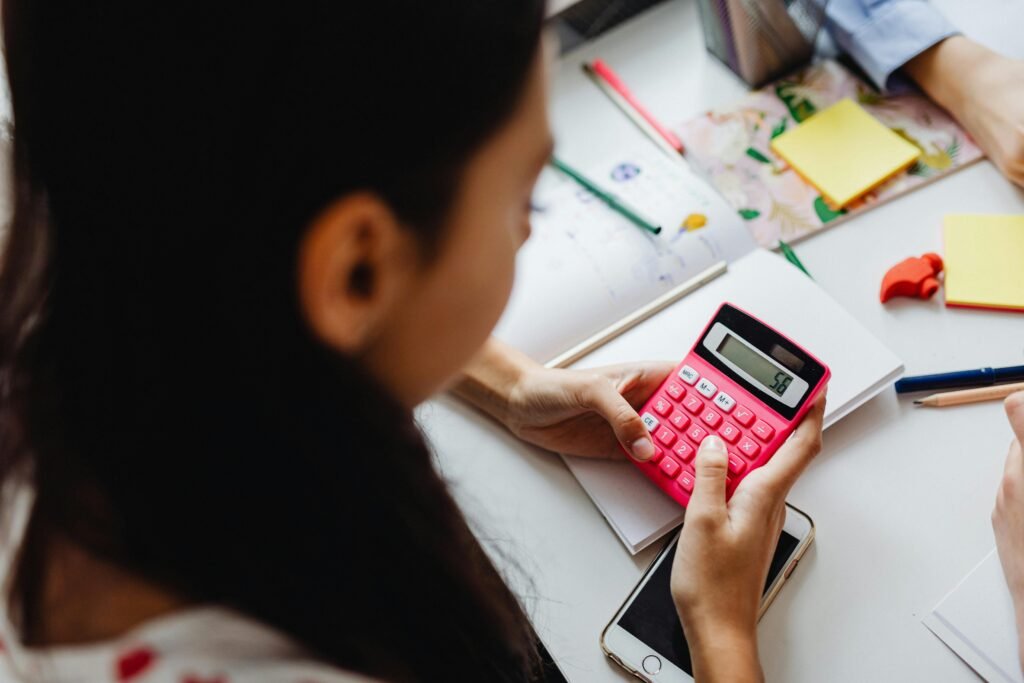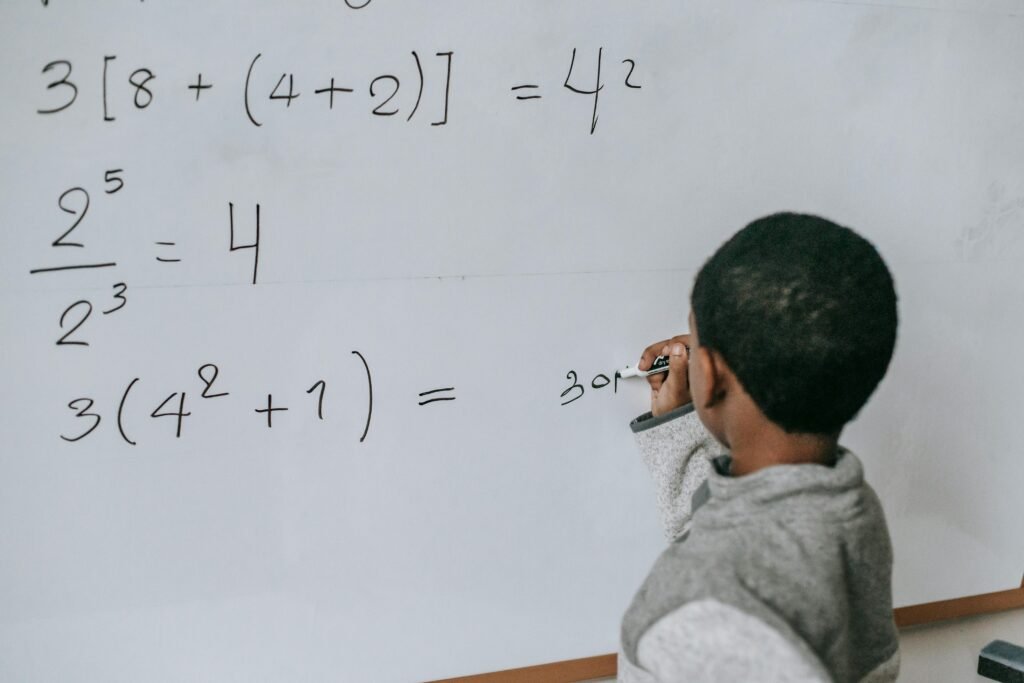In many homes and classrooms today, tablets are becoming a normal part of learning. But are they really helping? Especially in math, a subject many kids struggle with, can those daily tablet minutes truly boost understanding and confidence?
Students using tablets for math saw a 28% increase in test scores over one school year
A 28% increase in math test scores is no small thing. That kind of jump can move a child from falling behind to catching up—or even getting ahead. But how does it happen?
Here’s what the data shows: when kids use tablets for math in small, steady doses—say, 10 to 20 minutes a day—they tend to retain more. They can go at their own pace. They don’t have to rush like in class.
And most apps give instant feedback. So when a child gets a question wrong, the app explains why right away. That kind of immediate correction helps the brain remember the right answer faster.
But it’s not just about the tools. It’s how kids are using them. The key to this 28% increase is consistency. When students used math apps regularly, every day or almost every day, their brains built strong math habits. They started to see patterns. They learned from their mistakes. And slowly, their test scores rose.
If you’re a parent or teacher, the takeaway is simple: aim for steady practice. Don’t worry about spending an hour a day. In fact, shorter is often better. Just make sure it’s daily. Use an app your child enjoys, and help them build that habit. Over time, the improvement will show—not just in tests, but in confidence too.
Daily 15-minute tablet math sessions improved computation accuracy by 21%
What’s the point of doing math if the answers are wrong? Accuracy is a big deal. And the data shows that just 15 minutes a day on a math app can help a child get 21% more answers right.
That’s a big improvement, and here’s why it works. Most good math apps are built to train kids in fluency—doing problems quickly and correctly. They often include timed games or challenges. At first, kids might make mistakes. But with daily practice, they learn from those mistakes and start solving with fewer errors.
These short, focused sessions help because they don’t overwhelm the brain. A 15-minute window is just enough time for kids to practice without getting tired. And when they come back to it every day, their brains keep building those strong pathways for solving math problems quickly and accurately.
Want your child to get better at math? Try a simple trick: make 15 minutes of tablet math part of their daily routine. Maybe right after breakfast or before dinner. The key is to be consistent and to keep the mood light and fun. Celebrate their wins. Let them see their own progress. And if the app gives instant feedback, talk about what they got wrong and why. This kind of small habit can lead to big improvements.
78% of students who used iPads regularly showed higher engagement in math class
It’s no surprise—kids love screens. But it turns out, when used the right way, screens can help them love learning too.
A large number of students—78%—said they felt more engaged in math when they used iPads regularly. Engagement means more than just sitting still. It means they were thinking, asking questions, and actually wanting to solve problems. That kind of attention is gold for learning.
Why does this happen? Because iPads turn math into something active. Instead of listening to a teacher talk for a long time, kids are touching, tapping, and moving things on the screen. They’re solving puzzles. They’re unlocking levels. They’re part of the learning, not just watching it.
This engagement spills over into the classroom. When students have regular math time on tablets, they come into class ready. They already know some of the topics. They feel confident. And that makes them more willing to speak up, help others, or try hard questions.
So if your child often zones out during math class, try building up that excitement with a fun math app at home. It could be what they need to get curious again.
Schools using math tablet programs saw a 35% decrease in math failure rates
Now let’s talk about one of the most powerful stats of all: a 35% drop in failure. That’s not just about numbers. That’s about real kids going from struggle to success.
When schools added regular tablet math programs—especially ones built into the school day—they saw far fewer kids failing math. That means more students passed, and more felt good about their learning.
This didn’t happen by accident. These schools didn’t just hand out iPads. They made a plan. They chose apps that matched their lessons. They gave students time each day to work on them. And they checked in often to make sure kids were using them well.
Tablet programs help because they give kids a second chance to learn. Maybe they didn’t understand the lesson in class. But now, on the app, they can try again. They can watch a video or do practice problems at their own pace. And when they do this every day, things start to click.

If you’re part of a school or even a homeschool group, consider adding a structured tablet math program. Choose one that adapts to each child’s level. Build it into the daily schedule. Watch how those failure rates drop and how confidence grows.
Students doing math on tablets for just 10 minutes a day improved fluency by 25% in 8 weeks
Ten minutes. That’s less time than most kids spend brushing their teeth and picking out pajamas. But it’s all it takes to improve fluency by 25%.
Fluency means doing math quickly and correctly without having to think too hard. It’s a key skill. When kids are fluent, they can move on to harder math without getting stuck on basics.
Tablet apps are great at building fluency. They offer short, focused tasks that drill important facts—like addition, subtraction, multiplication, and division. The apps often have sound effects, rewards, or levels to keep kids going. And since the sessions are short, kids are more likely to stick with it.
In just eight weeks of daily 10-minute sessions, many kids started answering more questions in less time. That’s what fluency looks like. They weren’t stopping to count on their fingers. They just knew the answers.
To build fluency at home, try a math app with quick games and daily challenges. Make it part of your evening routine or after-school snack time. Praise effort, not just speed. And keep it light. The goal isn’t to be perfect. It’s to keep improving, one day at a time.
94% of teachers reported more consistent math practice with tablet use
Teachers notice patterns. And almost all of them—94%—said that when students had tablets, they practiced math more consistently.
That’s huge. Practice is the heart of math. You can’t just watch someone else do it. You have to try it yourself. But many students struggle to stay motivated. Paper worksheets can feel boring or overwhelming.
Tablets change that. With a good app, practice feels like play. Kids want to keep going. They want to beat their score or unlock the next level. And because the app keeps track of their progress, teachers can see who’s working and who needs help.
This consistency helps teachers too. They can plan better lessons when they know kids are getting steady practice. And they can target the students who need more support.
If you’re a parent or school leader, support your teachers by making sure students have access to tablet math apps at home. Ask the teacher what app they use in class. Try to match it at home. That way, learning stays smooth and steady on both sides.
Low-performing students using tablets improved by 2 grade levels in 6 months
Some students start behind in math. That’s just the reality. But with the right tools and a little consistency, they can catch up fast—sometimes faster than anyone expects.
The data shows that students who were struggling the most saw the biggest jumps. With regular tablet use, these low-performing students moved up two full grade levels in just half a year. That’s powerful. It means a 3rd grader struggling with 1st grade math could be doing 3rd grade work by the end of the year.
So why does this work so well for struggling learners? One big reason is that tablet learning is private. There’s no fear of embarrassment. Kids can work at their own level without feeling “behind.” They can take their time. They can try again. And the tablet never gets tired or frustrated.
Another reason is that the apps often adjust as the student learns. If a problem is too easy, the app makes it harder. If it’s too hard, the app offers help. This kind of smart learning path makes sure the child is always being challenged just enough—not too much, not too little.
If your child is falling behind in math, don’t panic. Start with just 10–15 minutes a day on a strong math app. Choose one that adapts and gives hints when needed. Track their progress weekly, and celebrate every little win. Those small steps add up fast.
87% of students said math became “more fun” when done on a tablet
If your child says math is “boring,” they’re not alone. But there’s good news: 87% of kids who used tablets for math changed their mind. They said math became more fun.
Why does fun matter? Because when something is fun, kids come back to it. They want to do it. They don’t need to be forced. And that kind of interest turns into better learning over time.
Most math apps know how to make learning playful. They mix lessons with games. They give stars, coins, or badges when a child does well. Some apps even let kids dress up characters, unlock new levels, or solve math puzzles in a story. It feels more like a game than a test.
This “fun factor” doesn’t take away from the learning. It adds to it. The more a child plays with numbers, the more they understand them. And the more they understand, the more they enjoy.
If your child dreads math time, don’t fight it. Change it. Find a math app that feels like play. Let your child try a few and pick the one they like best. Set a regular time each day for just 10–15 minutes of play-based learning. And watch how the attitude shifts from “ugh, math” to “can I do one more level?”
Schools with iPad-based math saw a 40% increase in student-led problem-solving activities
What does student-led problem-solving look like? It looks like kids thinking for themselves. It looks like them explaining ideas to each other, trying out different ways to solve a problem, and not giving up when things get tough.
And in schools where iPads were used for math, this kind of activity went up by 40%. That’s a huge shift in how students learn.
With tablets, kids aren’t just listening. They’re doing. They’re asked to figure things out on their own. And when they get stuck, they can get hints, not just answers. This builds grit and creativity—two important life skills that go far beyond math.

Also, many math apps today encourage kids to “show their work” in different ways. Some let them draw on the screen. Others ask them to explain their thinking before moving on. And in group settings, students often discuss what they did and why.
If you want your child to become a better problem solver, make sure their math app challenges them to think, not just guess. Look for apps that allow open-ended tasks or offer multiple ways to solve a problem. Ask your child to explain what they’re doing and why. This builds deep understanding—and helps them become confident, independent thinkers.
Tablet-based math apps helped improve math vocabulary retention by 33%
Math isn’t just numbers. It’s also words—words like sum, product, quotient, and factor. And if kids don’t understand these, they can get lost, even if they’re good at number crunching.
That’s where tablets come in. The data shows a 33% boost in math vocabulary when students used tablet-based learning. Why? Because many apps weave the words into the activity. They use audio, visuals, and repetition to help kids remember terms.
Instead of just reading “the product is the answer to a multiplication problem,” kids see it in action. They hear it, say it, and use it over and over in different settings. That’s how memory works—through layers of experience.
Some apps even add fun ways to explore vocabulary. Kids might match terms with pictures. Or hear the word and tap the right meaning. It’s learning by doing, not just reading.
To boost your child’s math language skills, use an app that includes vocabulary games or voice instructions. As your child plays, repeat the words out loud with them. Ask them to explain what “difference” or “estimate” means. And most of all, keep using the words during everyday math talk. That’s how these words stick—and how your child learns to speak the language of math.
Students who practiced math on tablets 4x per week scored 19% higher than peers
Practice makes progress—but it turns out, frequency matters just as much as time.
Students who practiced math four times a week on tablets scored 19% higher than those who didn’t. Not once a week. Not every now and then. Four times a week. That’s the sweet spot.
This tells us something important: it’s not about how long your child works each day. It’s about showing up regularly. Just like brushing teeth or eating healthy, steady habits win over random effort.
Four times a week is enough to keep learning fresh in the brain. It gives time for review and for new learning. It allows mistakes to be fixed before they become bad habits.
If you want your child to see real improvement, aim for four days a week. Pick the days that work best for your schedule. Keep each session short—10 to 20 minutes is plenty. And let your child mark their own progress. Maybe use a calendar to check off each day. This gives them a sense of control—and builds a routine they can stick to.
Tablet learners completed 60% more problems than textbook learners in the same time
When students used tablets instead of textbooks, they ended up doing 60% more math problems in the same amount of time. That’s not just a small difference—that’s a huge leap.
Why does this happen? The answer is simple: tablets make it faster and easier to move from one question to the next. There’s no flipping pages or writing answers by hand. The interface is smooth and quick. Plus, many math apps are gamified, so kids feel motivated to keep going. They want to get more points, unlock levels, or see their scores improve.
Also, tablet-based problems often come in short bursts. Kids don’t get overwhelmed by a long page of problems. They see one question at a time, solve it, and move on. This keeps the brain focused and reduces distraction.
Doing more problems isn’t just about quantity—it’s also about building fluency and confidence. The more problems a child works through, the more chances they have to notice patterns, learn from mistakes, and try again.
If you want your child to get more practice without more stress, tablets are your friend. Look for apps that offer quick, responsive tasks. Try timed challenges or problem races. And most importantly, make it a habit. Even 10–15 minutes can lead to dozens more problems solved—without the fight over worksheets.
80% of special education students showed stronger math performance using tablets
For students with learning challenges, traditional math tools don’t always work. But with tablets, the story changes. In fact, 80% of students in special education settings showed stronger math performance after using tablet-based learning.
Why? Because tablets offer customization. The text can be bigger. The sound can be louder. The pace can be slower or faster depending on what the student needs. Many math apps also use visuals, touch, and sound together, which helps students who learn in different ways.
These tools also reduce stress. Students can try again and again without feeling judged. The tablet doesn’t rush them. It doesn’t move on before they’re ready. And when they do get it right, it celebrates with them. That little boost of success means everything.
For parents of children with special learning needs, this is huge. You don’t need a long lesson plan. Just 10–15 minutes a day on a supportive, sensory-friendly app can lead to growth. Look for apps that offer settings to adjust the difficulty, read out loud, or include visuals. And stay involved. Sit with your child, praise their progress, and help them feel safe and excited about learning.
On average, tablet users gained 1.3 years in math ability over a 9-month school year
Imagine gaining over a year of learning in just one school year. That’s what happened for many students who used tablets for math: they showed an average growth of 1.3 years in just 9 months.

This means they didn’t just stay on track—they moved ahead. And it wasn’t because they worked longer or harder. It was because they worked smarter.
Tablet-based learning offers real-time feedback, customized lessons, and a fun environment that keeps kids coming back. Apps can adjust the difficulty automatically so students are always working at just the right level. Not too easy, not too hard.
And because kids are more engaged, they spend more time thinking about math. They get to review tricky skills, try advanced ones, and build stronger connections.
If your child is behind or just cruising, this stat should excite you. With the right program, they can leap ahead—and love doing it. Choose a math app that tracks growth over time. Many programs show “math age” or skill level. Use that to set small goals and celebrate progress. The secret is in showing up consistently and choosing tools that stretch your child just the right amount.
Schools with 1:1 tablet programs saw math proficiency rise by 32% in 12 months
When every child in a school has their own tablet and uses it for math, things change fast. In just one year, schools with 1:1 tablet programs saw a 32% rise in math proficiency.
This isn’t just about giving kids screens. It’s about creating equal access. Every student has the same chance to learn. There are no missing textbooks. No broken pencils. No waiting for help. The tablet is always ready to teach.
This setup also gives teachers powerful tools. They can see every student’s progress in real time. They can send custom practice to each child. And they can give faster feedback, which helps students learn quicker.
If your school doesn’t have a 1:1 program, you can still get similar results at home. Just one tablet and one good math app can make a huge difference. Keep it charged. Set up a learning schedule. Talk with your child’s teacher to sync up school and home work. Even if the school isn’t 1:1, your child can still get ahead.
Tablet users improved their math speed (problems per minute) by 42%
Speed in math isn’t everything—but it sure helps. Being able to solve problems faster gives students more time to think about harder questions later.
And with tablets, students got 42% faster at solving math problems. That means they were able to finish more problems in less time, with less hesitation.
Why? Because tablets give instant feedback. Students don’t have to wait until tomorrow to know if they got a problem right. They know right away. That speeds up the learning loop. They fix mistakes faster. They try again right away. And they build muscle memory.
Also, most math apps are designed to be snappy. The next question appears right after the last one. No long pauses or confusion. Just a smooth flow of learning.
If your child takes a long time to finish math homework, try a tablet app that builds speed. Start slow. Don’t focus on speed at first. Focus on confidence. As they get better, they’ll naturally pick up speed. And when they start beating their own best times, they’ll feel proud—and keep going.
69% of students reported increased confidence in solving math problems after using tablets
Confidence in math can make or break a student’s learning journey. When kids believe they can do it, they usually do better. And that’s exactly what happened with tablet learning—69% of students said they felt more confident solving math problems after using tablets regularly.
Why does confidence grow with tablets? For starters, these tools give kids space to fail privately. There’s no public mistake on the board. No embarrassment. They can try again quietly, learn from feedback, and keep going until they get it right.
That sense of “I got this” grows quickly when success is built in. Many math apps offer progress bars, badges, stars, or simple praises after every question. Kids see they’re moving forward, and that feels good. It’s not just about scores—it’s about seeing improvement day by day.
Confidence also grows because kids feel more in control. With tablets, they can choose their pace. They can repeat a lesson. They can pause. All of this builds independence, which leads to deeper confidence.
If your child is scared of math or gives up easily, start small. Give them a gentle, fun math app and let them build skills at their level. Focus on wins, no matter how small. Celebrate them. That’s how confidence builds—step by step.
iPad math users made 50% fewer calculation errors than traditional learners
Let’s face it—math is full of tiny details. One wrong number, and the whole answer is off. But here’s something exciting: students using iPads made 50% fewer calculation mistakes compared to those learning the old-fashioned way.
That’s a big deal. Fewer errors means better scores, less frustration, and a lot more progress.
How does it happen? First, many tablet apps use color, animation, or audio to highlight mistakes right away. So when a student types in the wrong answer, the app doesn’t just say “wrong.” It shows why. That instant feedback helps the brain fix the error on the spot.
Second, the digital format helps reduce silly mistakes. No smudged numbers. No skipped lines. Kids focus on the question in front of them—clearly and cleanly.
Also, many apps mix in review and repetition automatically. If a child keeps making the same mistake, the app brings it back later. This built-in memory system helps them learn deeply and reduce future errors.
Want to help your child make fewer mistakes? Pick a math app that gives real-time feedback and explains why an answer is wrong. Encourage your child to pause and read those explanations carefully. With time, their accuracy will soar.
83% of teachers observed better attention span during math sessions on tablets
Attention spans are shrinking in many areas—but when it comes to tablet learning, the story flips. 83% of teachers said students stayed more focused during math sessions on tablets than during regular lessons.
That’s a powerful insight. It means that when used correctly, tablets can actually improve concentration—not hurt it.
One reason is the format. Tablets usually present one question at a time. There’s nothing else on the screen. No distractions. Just a problem, ready to be solved. This helps students stay locked in without jumping ahead or zoning out.

Also, the interactive elements of most apps—like sound effects, animations, or challenges—hold a child’s interest. It feels like a game. And games are designed to keep you paying attention.
Another benefit? Many math apps include timers or goals. “Solve five problems in two minutes.” These simple challenges give students something clear to focus on, which improves engagement.
If your child struggles to sit still for math, a tablet might be the tool that changes everything. Choose an app with short tasks, visual rewards, and a clear path to follow. And keep sessions brief—10 to 15 minutes is usually enough to stay in the zone.
Students using interactive math apps completed lessons 25% faster
Time matters. Kids don’t want to sit for hours, and parents don’t want battles over homework. That’s why this stat is so exciting: students using interactive math apps finished their lessons 25% faster than students using traditional methods.
That’s right—quicker lessons, same learning (or better).
Why so fast? Because tablets remove friction. There’s no need to copy questions by hand. No page flipping. No waiting for the teacher to explain again. Everything is immediate. Tap, solve, move on.
Interactive apps also use design to keep things flowing. Bright visuals, animated feedback, and quick transitions help the brain stay in motion. There’s less downtime, and more active thinking.
This speed isn’t about rushing. It’s about working efficiently. And when kids finish faster, they often feel more motivated. They get time back. They feel successful. And they’re more likely to come back tomorrow without a fight.
Want to save time on math without skipping learning? Try an app that breaks lessons into short, interactive parts. Focus on quality, not quantity. Let your child finish early if they’re doing well—that freedom is a big motivator.
Tablet math users outperformed non-users by 22 percentile points in standardized math tests
Standardized tests might not be perfect, but they’re still a big part of school life. And here’s the big win: students who used tablets for math regularly outscored non-users by 22 percentile points on standardized math exams.
That kind of jump can move a student from average to excellent—or from behind to right on track.
This boost happens because tablet learning builds deep math fluency. Kids don’t just memorize—they understand. They practice often, get feedback quickly, and apply what they learn right away.
Also, many apps are designed with test formats in mind. They teach the skills students are likely to be tested on—word problems, multiple choice, computation, logic puzzles, and more. And because the practice is frequent and enjoyable, the learning sticks.
If your child has big tests coming up, make tablet time part of their prep. Choose apps that align with their grade level and curriculum. Set a schedule—just 15 minutes a day. Review the areas where they’re weakest. And help them walk into those tests feeling ready.
Gamified math apps increased time-on-task by 38%
Getting kids to stick with something—even for a few minutes—can be hard. But gamified math apps changed that, increasing student time-on-task by 38%. That means kids stayed focused longer, did more problems, and learned more—all without being told to.
So what’s the magic behind gamification? It’s simple: games are fun. They pull kids in and keep them going. But when games are mixed with learning, something even better happens. Kids don’t just have fun—they build skills while they’re at it.
Gamified apps use levels, rewards, and challenges to create excitement. For example, a student might solve 10 problems to unlock a treasure chest. Or beat a timer to earn a badge. These little wins build momentum and make practice feel like play.
This doesn’t mean kids are just zoning out with games. These apps are smart. They only give rewards when the answers are right, and many give explanations when kids get things wrong. So students are still learning, still thinking—just in a way that feels joyful instead of boring.
If your child struggles to stay focused on math, don’t force it. Find a math game app that’s actually fun. Let them explore it, and encourage them to beat their own best scores. You’ll be surprised how long they’ll stay on task when they’re having a good time.
Schools saw a 27% improvement in homework completion with tablet math programs
Getting kids to do math homework is often a battle. But when schools switched to tablet-based programs, something amazing happened: homework completion jumped by 27%.
That’s not just more math done—it’s more learning, more confidence, and fewer missed skills.

Why does this happen with tablets? First, the barrier to starting is lower. Kids don’t need pencils, erasers, or printed worksheets. They just open an app and get going. The path is clear, and the process is smooth.
Also, many math apps make homework feel more like a mission or game. Kids might earn stars, points, or even progress through a story as they complete their work. That turns “ugh, I have to do this” into “cool, what’s next?”
Another big win: instant feedback. Kids don’t have to wait a day or more to know if they got the answers right. They learn as they go. That real-time correction helps the brain remember what works—and fix what doesn’t.
If homework is a daily struggle at your house, switch things up. Ask your teacher if they can recommend a tablet-based program that matches the school curriculum. Set a consistent time each day, and let your child enjoy the process instead of dreading it.
Tablet math minutes contributed to a 15% boost in students’ logical reasoning skills
Math isn’t just about numbers. It’s also about thinking. And tablets are helping with that too. In fact, students who used math apps regularly saw a 15% boost in logical reasoning.
Logical reasoning is what helps kids solve word problems, break down puzzles, and connect math to real life. It’s the kind of thinking that helps in science, coding, and even decision-making.
Math apps are great at building this skill because they present problems in many different ways. Instead of just “What is 8 + 4?” they might ask “I had 8 apples. I picked 4 more. How many now?” or “If I want to make 12, what numbers can I add?”
These little shifts help kids stretch their thinking. They don’t just memorize—they understand. Some apps even use logic games or math stories to make this learning fun and engaging.
If your child struggles with problem-solving or gets lost on multi-step problems, try an app that includes puzzles and logic games. These build deep math thinking without feeling like schoolwork. And over time, that 15% boost can lead to big wins in every subject.
Math anxiety dropped by 46% among students using iPads regularly
For many kids, math feels scary. Their stomach hurts before a test. Their heart races when they see a hard problem. But here’s the hopeful news: math anxiety dropped by nearly half—46%—for students who used iPads regularly.
Why such a big change? Because iPads create a safe learning space. No one is watching when they mess up. There’s no fear of raising a hand and being wrong. It’s just the child, the app, and the chance to try again.
This helps kids feel more in control. They can go back, repeat lessons, or slow down when needed. That control builds confidence, and confidence reduces fear.
Many apps also make math feel playful. Instead of a long, tense worksheet, it’s a game. A challenge. A riddle. When math feels less like a test and more like an adventure, kids stop worrying—and start enjoying.
If your child says “I’m just bad at math” or cries before homework, it’s time to shift the story. Let them explore math in a no-pressure setting. Choose an app that feels kind and calm, not competitive. Stay close at first, cheer them on, and let the anxiety melt away.
Students practicing math on tablets showed 31% more persistence on tough problems
When things get hard, some kids give up right away. Others keep trying. That “keep trying” muscle is called persistence—and tablets help build it. In fact, students using tablets for math showed 31% more persistence when faced with tough problems.
This isn’t about forcing kids to grind through frustration. It’s about giving them tools that help them keep going without fear.
Most math apps are built with support in mind. If a child misses a problem, they get hints or guided steps instead of just a red “X.” This shows them how to try again instead of giving up.
Also, many apps include built-in encouragement. A little cheer sound, a smiley face, or a “you’re close!” message can go a long way. These tiny bits of praise keep motivation high, especially when things get tricky.
Persistence matters because it teaches kids that effort is valuable. It helps them face challenges, not avoid them. And that mindset will serve them well far beyond math class.
If your child gives up easily, try a math app with built-in hints or step-by-step breakdowns. When a problem gets tough, sit with them and talk through it. Show them how good it feels to solve something that wasn’t easy. That’s where the real learning lives.
73% of parents reported their child enjoyed math more when using a tablet
Parents know their kids. And when 73% of parents say their child enjoys math more when using a tablet, that’s worth paying attention to.
Enjoyment is the first step to success. If a child hates something, they’ll avoid it. But if they like it, they’ll come back to it—even when it gets hard. That consistent return is what builds skill and confidence over time.
Why do tablets make math more enjoyable? One reason is that learning becomes visual and interactive. Kids aren’t just solving problems—they’re playing, exploring, building, and achieving. That makes math feel alive.
Another reason is independence. Kids love the feeling of “I did this by myself.” With tablets, they can work on their own, get feedback right away, and move at their own pace. This control turns frustration into pride.
Parents also report that there’s less resistance at homework time. Kids are more willing to do math when it’s on a tablet. That alone makes family life smoother—and learning more consistent.
If you want your child to enjoy math more, try offering choice. Let them pick the app or choose between two math games. Set a relaxed, no-pressure time for practice. And join in sometimes—ask them to teach you how to play. That shared experience adds joy and makes learning something they want to do.
Tablet programs reduced the math achievement gap for ELL students by 29%
English Language Learners (ELLs) face a tough challenge: learning a new language while trying to keep up with math. But with the right tools, they can thrive. In fact, tablet-based programs helped close the math achievement gap for ELL students by 29%.
That’s huge. It means that with the help of tablets, many ELL students are no longer falling behind in math just because they’re still learning English.
How does this work? Most quality math apps use visual instructions, audio support, and animations. That way, students don’t need to read complex text to understand the question. They can hear it, see it, and interact with it—even if their English is still developing.
Many apps also offer language settings, allowing students to get instructions in their home language while practicing math in English. This supports understanding and builds vocabulary at the same time.
If your child is learning English and struggling in math, try a bilingual or visual-based math app. Focus on programs that let your child see and hear math terms, not just read them. This dual support bridges the gap and builds confidence fast.
Tablet-based tracking led to 45% faster interventions for struggling math learners
One of the hardest parts of teaching math is knowing exactly when a child needs help. But tablet-based learning is changing that. Schools using tablets reported 45% faster interventions for students who were falling behind.
What does this mean? It means teachers noticed problems earlier—and could step in faster. That’s a game changer for kids who are struggling.
Most math apps track student performance in real time. Teachers and parents can see which questions were missed, how long a child took on each one, and which concepts they’re stuck on. This insight helps adults offer support right away—before the struggle becomes a serious gap.
Some apps even send alerts or summaries to teachers, showing which students need review or extra help. That kind of smart feedback can turn a bad math week into a better one.
At home, this tracking helps too. Parents can review progress, spot problem areas, and guide their kids without guessing. It takes the stress out of wondering “how are they doing?”
To use this tool, pick a math app with a good dashboard or parent report system. Set a routine where you check it once a week with your child. Talk about what’s going well and what needs work. These tiny check-ins make sure no one falls through the cracks.
Schools using tablets for math saw an average 8-point gain in national math assessments
The final stat brings everything together. Across the board, schools that used tablets for math saw an average 8-point gain on national math assessments. That kind of jump is proof that all these small wins add up to big success.
An 8-point rise isn’t just about better test scores. It’s about stronger skills, deeper understanding, and more kids reaching grade-level goals. For some schools, that means moving out of low-performance labels. For others, it means reaching higher and pushing students into advanced work.
This rise came from consistent use of tablet programs—not just during math class, but across homework, review, and skill-building time. The schools that saw the most gains focused on steady routines, teacher support, and high-quality apps that matched their learning goals.

For families and schools alike, this stat is encouraging. It shows that when we use technology wisely, it can close gaps, build confidence, and raise achievement across the board.
If you’re a parent, ask your school if they use tablets for math—and how you can support it at home. If not, you can still build your own program. Choose a great app. Set a daily or weekly routine. Track progress. Celebrate growth. Those 8 points could be waiting just around the corner.
Conclusion
All the numbers we’ve walked through tell one clear story—tablet time works. It’s not just a fun extra or a digital toy. When used with purpose and consistency, those daily math minutes on an iPad or tablet can completely change the way a child learns math.



